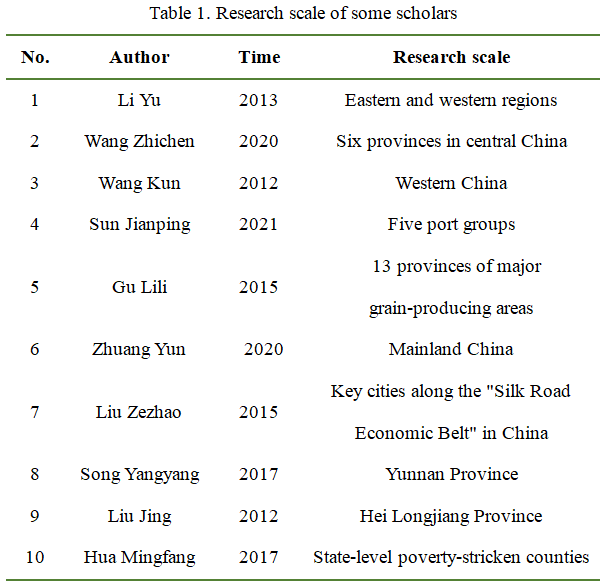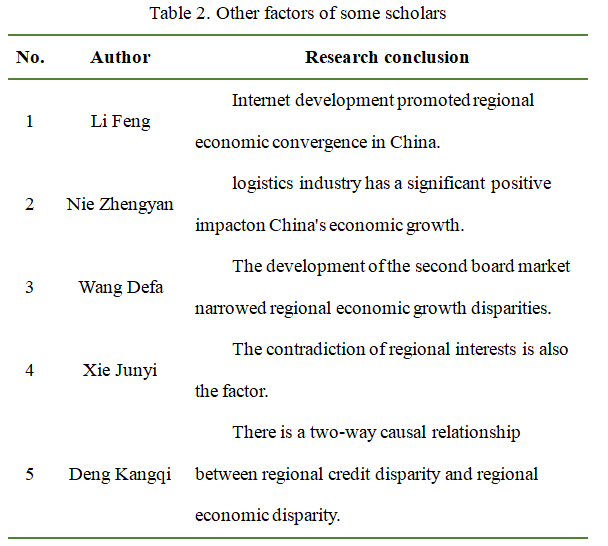Научная статья
Original article
УДК 911.3:332(510)
doi: 10.55186/2413046X_2022_7_7_450
A REVIEW ON THE DEVELOPMENT OF REGIONAL ECONOMIC DISPARITIES IN CHINA IN RECENT 10 YEARS
ОБЗОР РАЗВИТИЯ РЕГИОНАЛЬНЫХ ЭКОНОМИЧЕСКИХ ДИСПРОПОРЦИЙ В КИТАЕ ЗА ПОСЛЕДНИЕ 10 ЛЕТ
Guo Yongchao, 2-year postgraduate student, Smolensk State University, Xinxiang South Taihang travel Co. LTD. Xinxiang City, Henan Province, China
Го Юнчао, аспирант 2 курса Смоленского государственного университета, Xinxiang South Taihang travel Co. LTD. Город Синьсян, провинция Хэнань, Китай
Abstract. With the rapid development of China’s economy, regional economic differences have become a hotspot in social research. This paper collects literatures on China’s regional economic disparities from 2012 to 2021, and summarizes them from five aspects: research scale, research method, evolution of regional economic disparities, influencing factors and countermeasures.
Аннотация. С быстрым развитием экономики Китая региональные экономические различия стали горячей точкой в социальных исследованиях. В этом документе собрана литература о региональных экономических диспропорциях Китая с 2012 по 2021 год и обобщена по пяти аспектам: масштаб исследования, метод исследования, эволюция региональных экономических диспропорций, влияющие факторы и контрмеры.
Keywords: China, regional economic differences, the research reviewed
Ключевые слова: Китай, региональные экономические различия, обзор исследований
In 1978, China carried out “reform and opening up”and entered a period of rapid economic development, with some regions rapidly leading the economy. However, with the progress of science and technology, economic development and industrial reform, China’s regional economic differences are increasingly obvious, becoming the focus of social attention. This paper will sort out the research literature on China’s regional economic disparities in the past 10 years from the following five aspects.
Research Scale
Most of the literatures analyzed regional economic differences from the national level, and some scholars studied them from the economic zone, provincial level, city and county level (Table 1).
Research Methods
Most literatures use the combination of qualitative and quantitative research, using economic coefficient, spatial model and other methods for data analysis.
Zhang Weishi (2012) provided a new perspective to explain the generation mechanism of China’s regional disparities based on the theoretical analysis framework of soft input. Guan Xingliang (2012), based on the connotation and characterization method of spatial field energy, discussed the spatio-temporal characteristics of the three regions in China.Zhang Li (2014) empirically tested the relationship between institutional quality and regional economic growth differences in China by using unit root test, co-integration test and Granger causality test.
Sun Jiuwen (2014) used standard deviation coefficient, coefficient of variation, Gini coefficient, Theil index and geographically weighted regression model (GWR) to analyze the evolution law of regional economic development differences in China from 1978 to 2012. Peng Xin (2015) used Gini coefficient, Mann-Kendall, Markov chain, spatial autocorrelation, spatial error model and geographically weighted regression method to conduct a phased study on China’s regional economic differences. Feng Changchun (2015) used Theil index second-order decomposition and ESDA spatial statistical method to explore the spatio-temporal evolution of regional economic differences in China. Li Qiang (2021) analyzed the evolution characteristics and driving mechanism of China’s economic development pattern from 2000 to 2018 by using multiple temporal and spatial analysis methods including imbalance index,coefficient of variation, Natural Breaks (Jenks) classification, ESDA and geographic detector model.
Jiang Xiaojun (2019) measured the time series evolution and scale nesting characteristics of regional economic differences at different spatial scales with comprehensive index model, difference index model and scale nesting model.
Influencing factors
Through sorting out the research literature, it is found that there are many factors leading to regional economic differences in China, including location resources, policy system, scientific and technological innovation, capital, industrial transfer and other factors.
3.1 Location Resources
Cai Jingfeng (2015) put forward spatio-temporal difference is the internal reasons for the difficult balanced development of regional economy.He Xionglang (2013) pointed out that the factors promoting economic development mainly lie in the quality of factor endowment.
3.2 Policy System
Han Fuguo (2012) conducted multidimensional data analysis on the finalists of the five China Local Government Innovation Awards (2001-2010) and found that administrative reform was significantly correlated with economic growth. Huang Hui (2013), Zhang Li (2014) and Yang Dongmei (2016) believe that institutional differences are an important reason for regional economic growth differences in China.Zhang Pengfei (2018) pointed out that different economic policy orientations among regions determine regional differences in economic growth performance.
3.3 Scientific and technological innovation
Qi Weina (2014) found that the increase of R&D expenditure and technology market turnover had a positive effect on the economy. Li Zaijun (2017) pointed out that the difference in comprehensive innovation ability has a great overall impact on economic difference.Ye Xiuqun (2015) showed that technological innovation and the improvement of higher education had an obvious positive promoting effect on regional economic growth.
3.4 Capital
Lin Muxi (2012) found that social capital has a significant impact on regional growth differences. Zhang Jiazi (2015) believes that foreign direct investment is an important reason for the difference in regional economic development in China, while Chen Yuanyuan (2014) believes that domestic investment has the greatest force on regional economy.
Empirical studies by Wang Hanfeng (2018) and Tang Shenlu (2019) show that FDI has a direct impact on regional economic disparities in China, and domestic investment is an important force to promote economic growth.
3.5 Industrial transfer
The results of Zhuang Yun (2019) show that the transformation of regional development strategy and industrial transfer play an important role in narrowing China’s regional economic differences. Li Jingjing (2019) points out that industrial transfer can promote China’s regional economic growth and reduce the imbalance of regional economic.
3.6 Other Factors
In addition to the above influencing factors, some scholars also put forward other influencing factors, as shown in Table 2.
Strategy
In view of the current regional economic differences in China, various scholars put forward suggestions and strategies, mainly focusing on the following aspects: First, policy support, change ideas and actively seek development; Secondly,regional integration to improve urban agglomeration spatial governance system;Thirdly,Strengthening infrastructure construction to lay a foundation for coordinated development; Fourth, pay attention to personnel training and enhance the driving force of regional economic development.
Conclusion
Through combing the literature on the development of regional economic disparities in China in recent 10 years, it is found that the research scale is wide and the research methods are diverse. However, in the economic development of various regions, scientific and reasonable measures should be taken to ensure the coordinated development of different regions.
References
- Zhang Weishi. Comparative Study on Soft Input and Regional Economic Development in China [D]. Lanzhou University, 2012
- Guan Xingliang, Fang Chuanglin, Luo Kui. Evaluation of regional economic development differences in China based on spatial field energy [J].Geographical Science, 2012,32(09),1055-1065
- Zhang Li, Huang Hanmin, Guo Suwen. Granger causality analysis of institutional quality and regional economic growth differences in China: based on China’s regional panel data [J].East China Economic Management, 2014,28(02),59-63
- Sun Jiuwen, Yo Peng. Research on regional Economic Disparities in China based on the perspective of spatial heterogeneity [J]. Shanghai Economic Research, 2014,(05),83-92
- Peng Xin. Regional economic disparities in China at different spatial scales [D]. Nanjing Normal University,2015.
- Feng Changchun, Zeng Zanrong, Cui Nana. Spatio-temporal evolution of regional economic disparities in China since 2000 [J]. Geographical Research, 2015,34(02),234-246
- Li Qiang, Wei Jianfei, XU Bin, Pu Yuchi. Evolution and driving mechanism of multi-scale pattern of regional economic development in China from 2000 to 2018[J]. Economic Geography, 201,41(12),12-21
- Jiang Xiaojun. Spatio-temporal Evolution characteristics and Driving mechanism of Regional economic disparities in China at multiple scales [D]. Northeast Normal University.2019
- Cai Jingfeng. Analysis on the Spatio-temporal Differences of Regional Economic Development in China [J]. Modern Economic Information, 2015,(01),467+476
- He Xionglang, Zheng Changde. Reflection and prospect of new economic geography[J].Journal of Shanghai University of Finance and Economics, 2013,15(06),48-55
- Han Fuguo. The relationship between local government innovation and regional economic growth: a cross-case study based on the differences of local government innovation in China [J].Journal of Zhejiang University (Humanities and Social Sciences Edition), 2012,42(02),161-177
- Huang hui. Institutional analysis of regional differences in China’s economic growth [J]. Economic Geography, 2013,33(01),35-40
- Yang Dongmei, Jiang Ming. An empirical study of China’s regional economic growth disparities [J].China Development, 2016,16(06),72-78.
- Zhang Fengfei, Li Guoqiang, Hou Linke, Liu Mingxing. Rethinking the differences in regional economic growth: historical causes and evolutionary logic. Economic Quarterly, 2019,18(01),151-166
- QI Weina, Zhang Yaohui. Entrepreneurship, knowledge spillover and regional economic growth differences: An Empirical Analysis based on panel Data of 30 Provinces and cities in China [J]. Journal of Economic and Management Research, 2014,(09),23-31
- Li Zaijun. Evolution characteristics of unbalanced geographical development of Regional economy in China: A Review from the perspective of Capital Circulation Logic [D]. Nanjing Normal University, 2017
Для цитирования: Guo Yongchao. A review on the development of regional economic disparities in china in recent 10 years // Московский экономический журнал. 2022. № 7. URL: https://qje.su/ekonomicheskaya-teoriya/moskovskij-ekonomicheskij-zhurnal-7-2022-60/
© Guo Yongchao, 2022. Московский экономический журнал, 2022, № 7.





